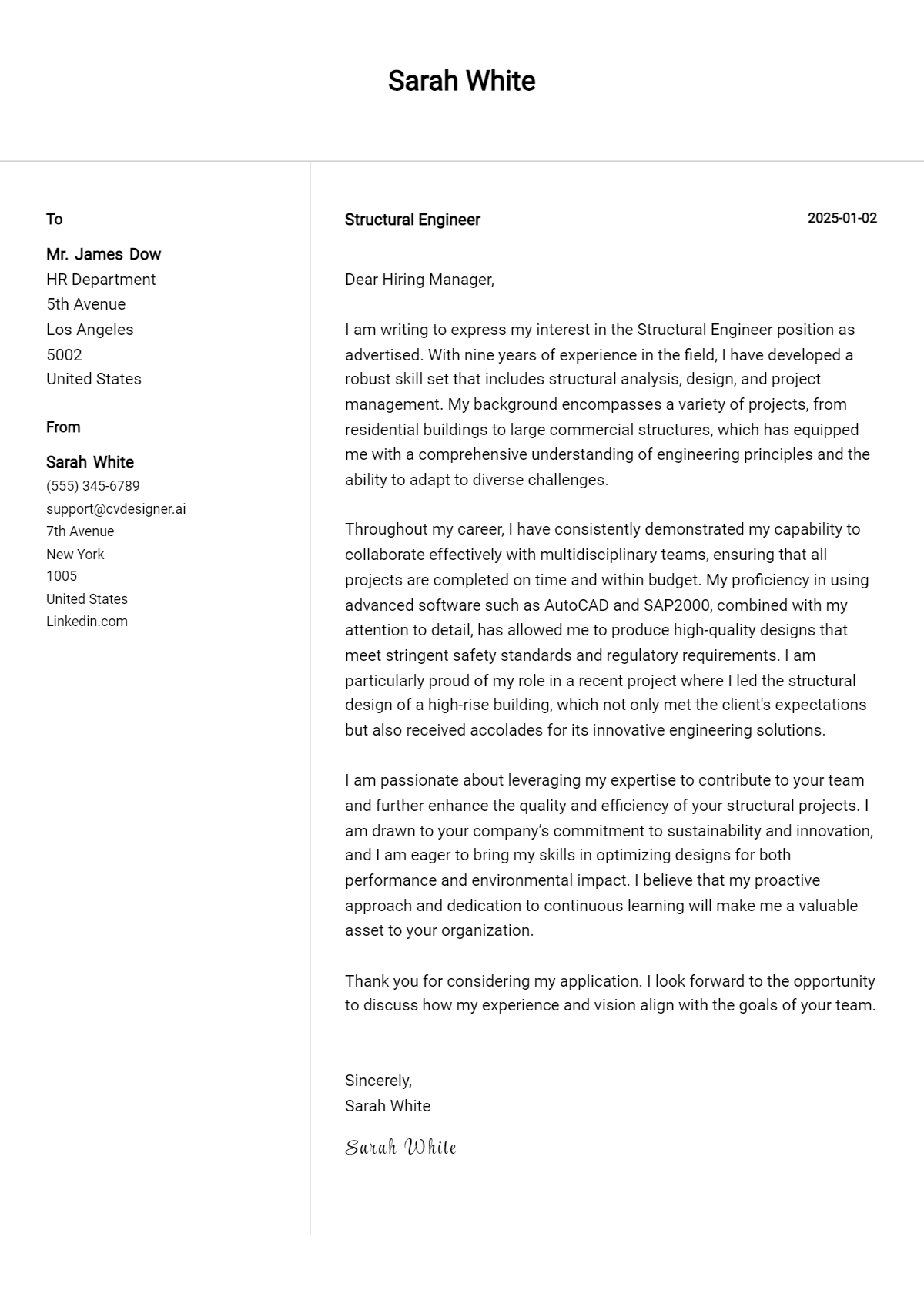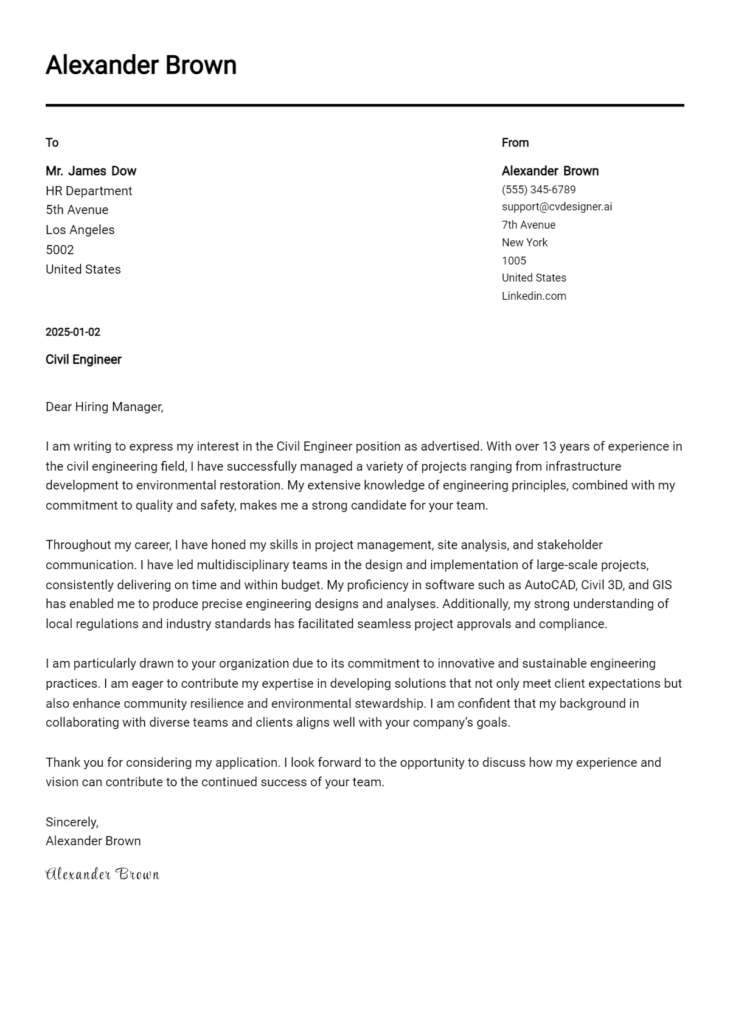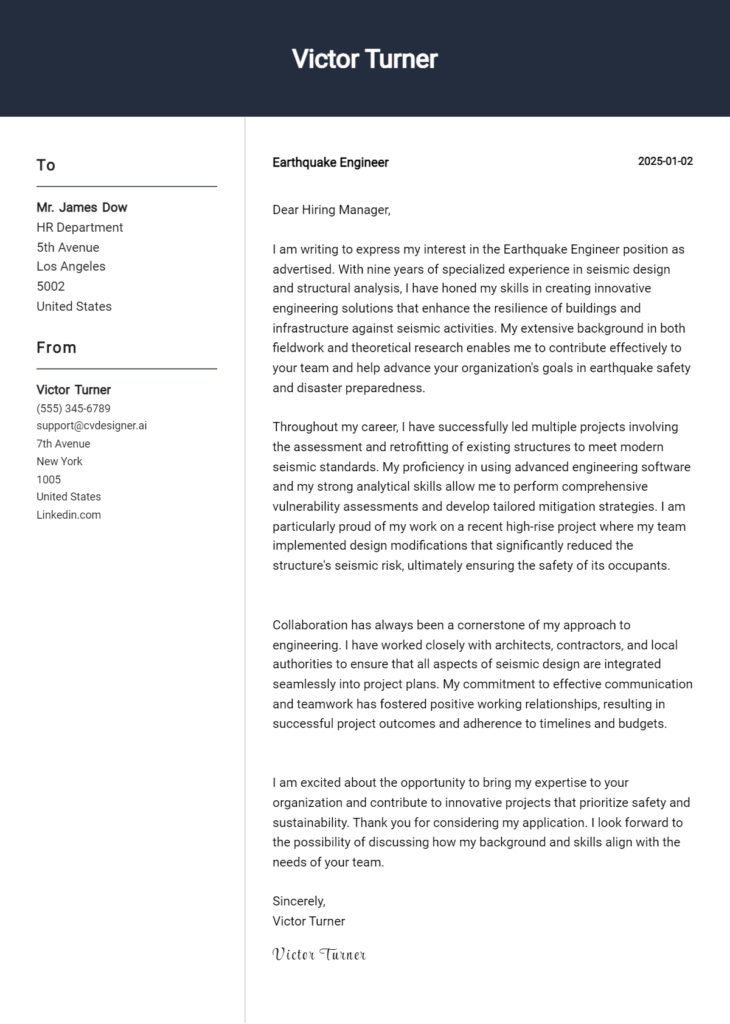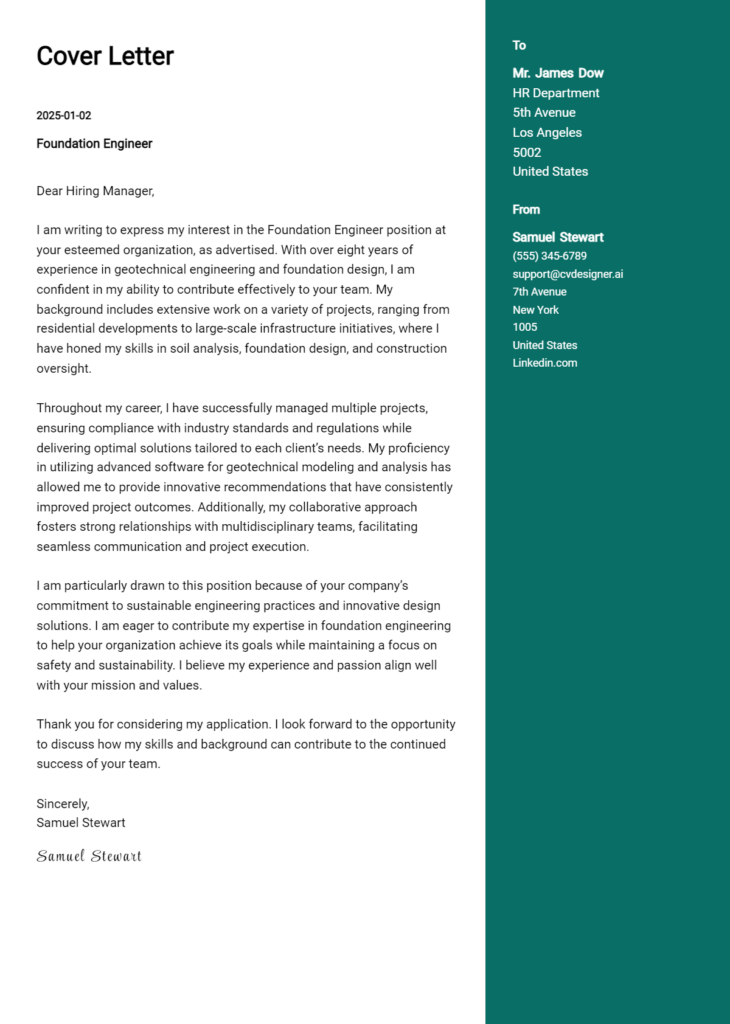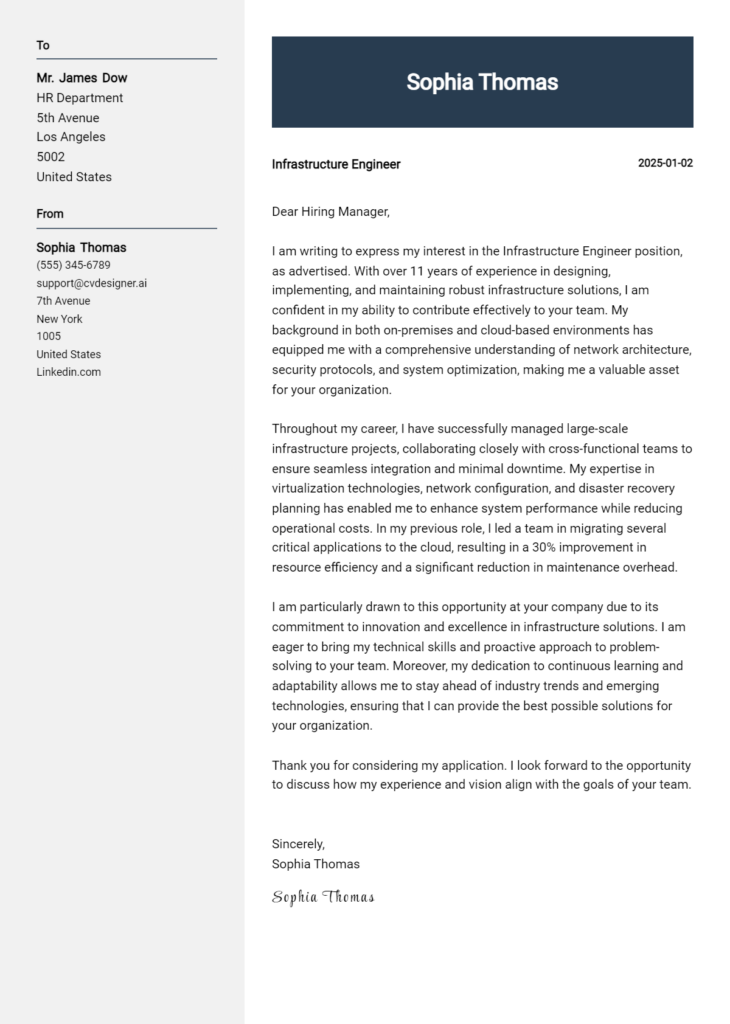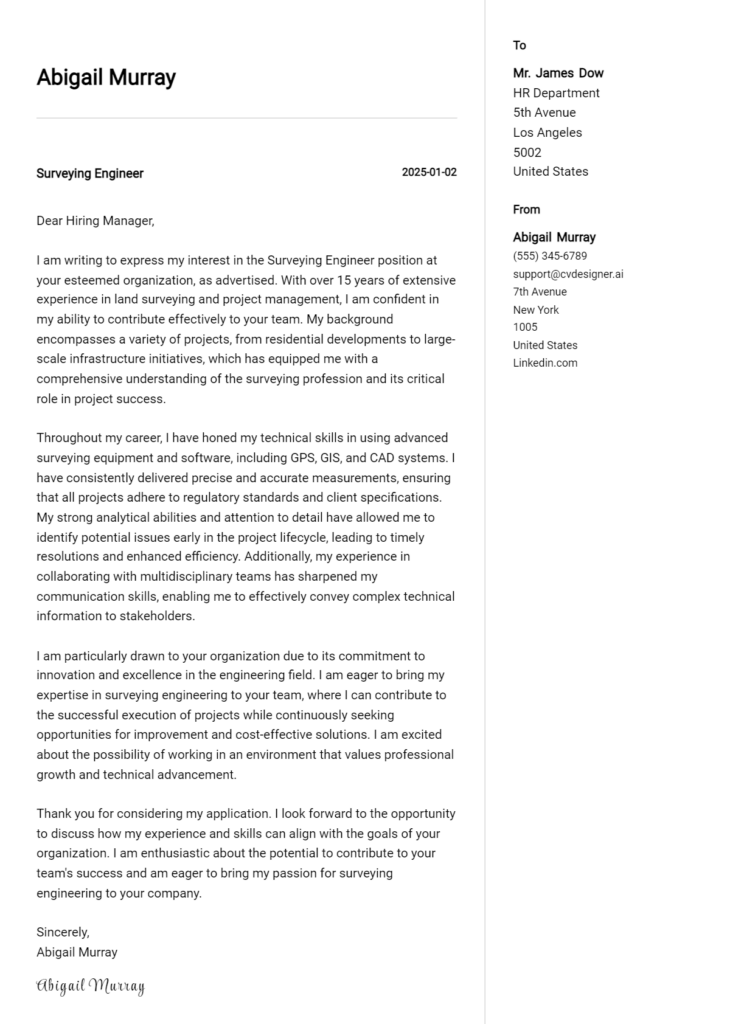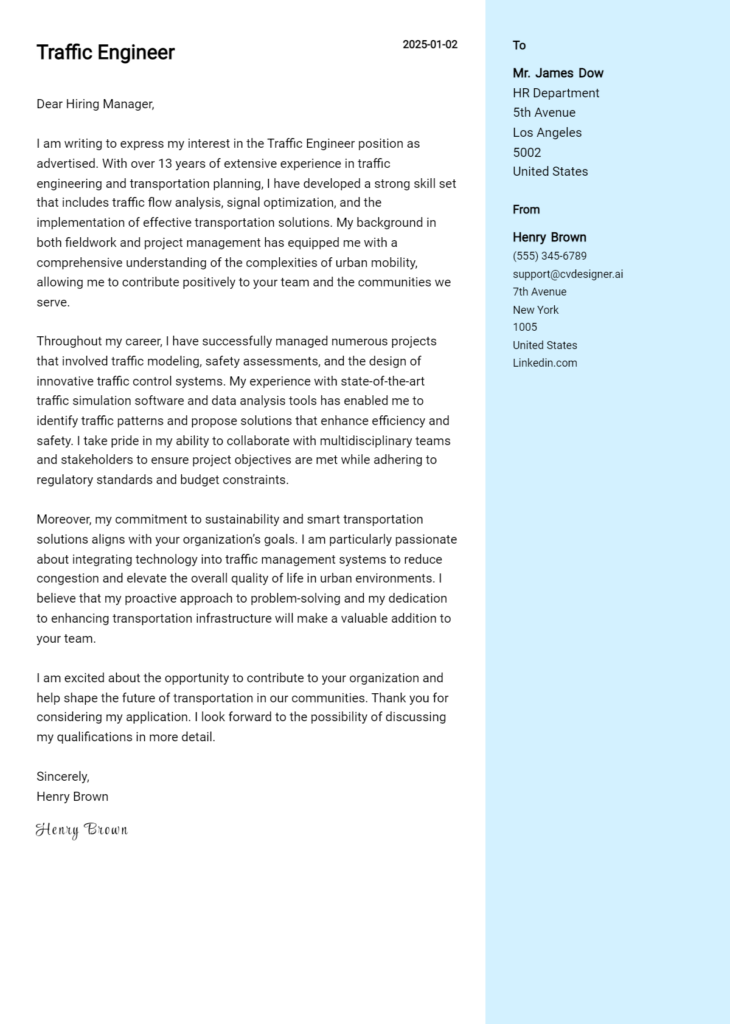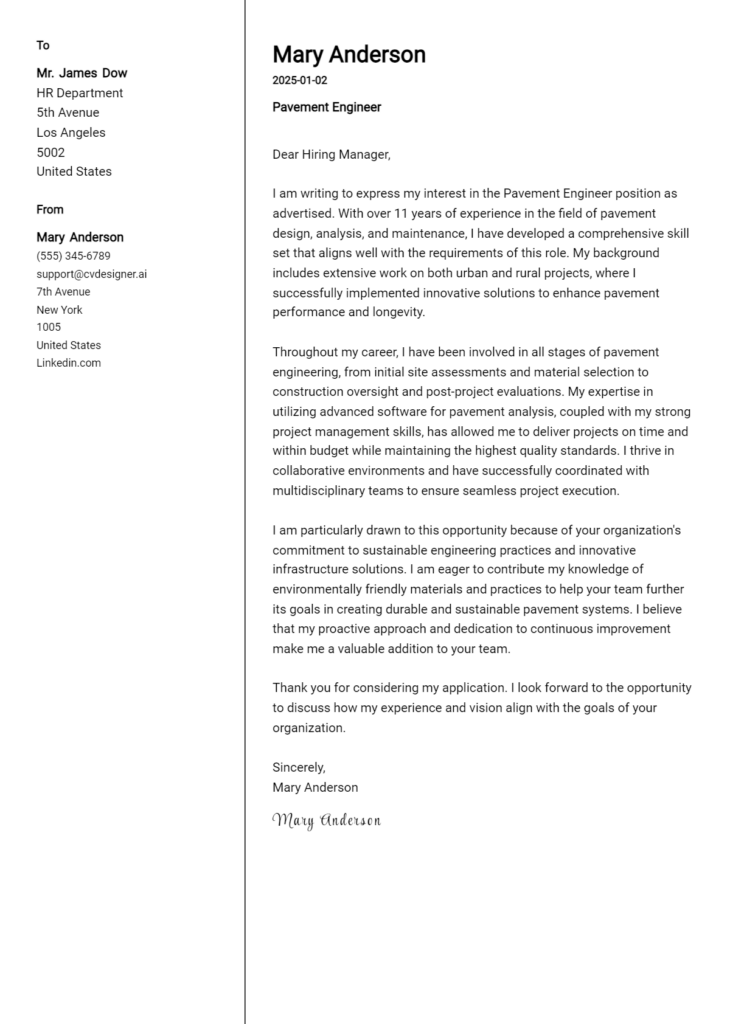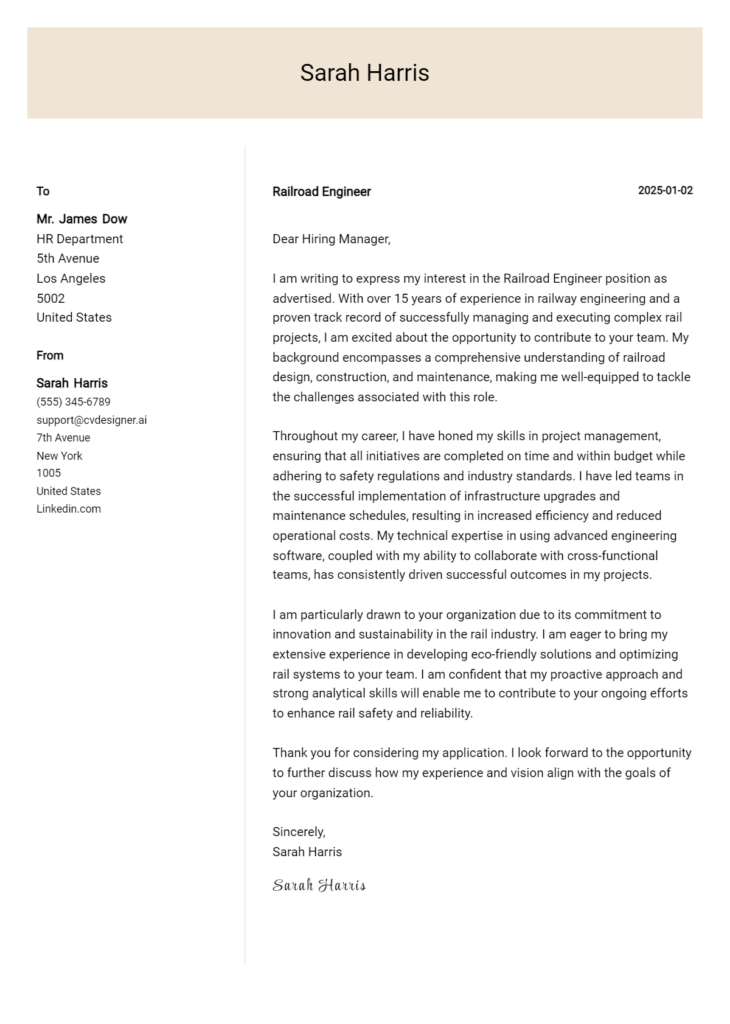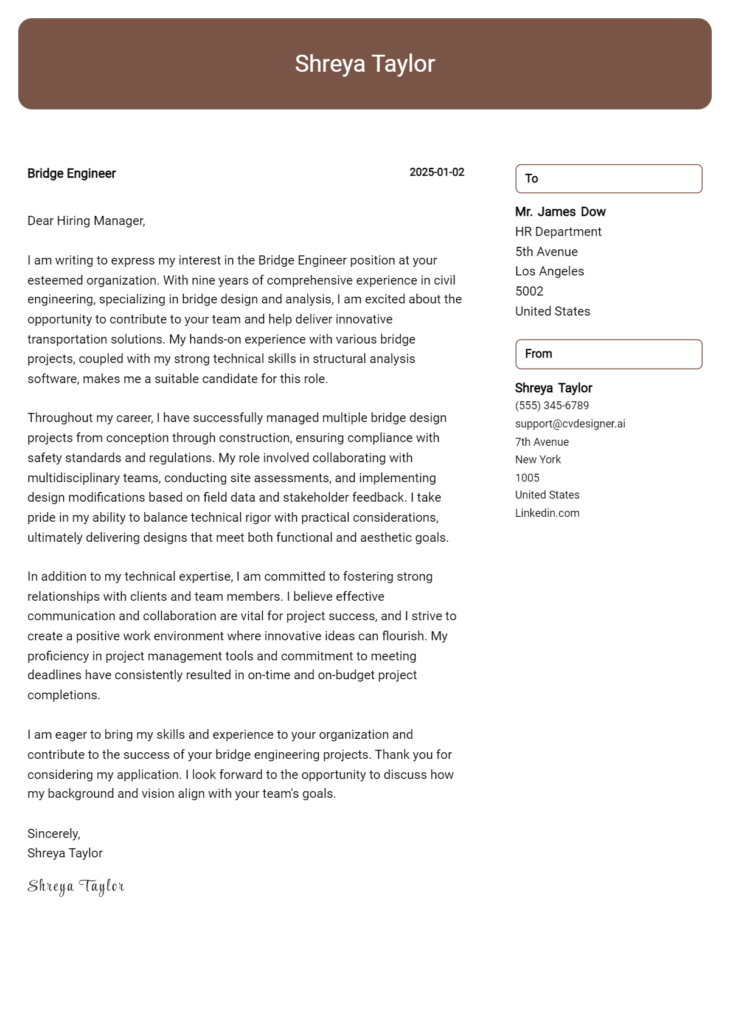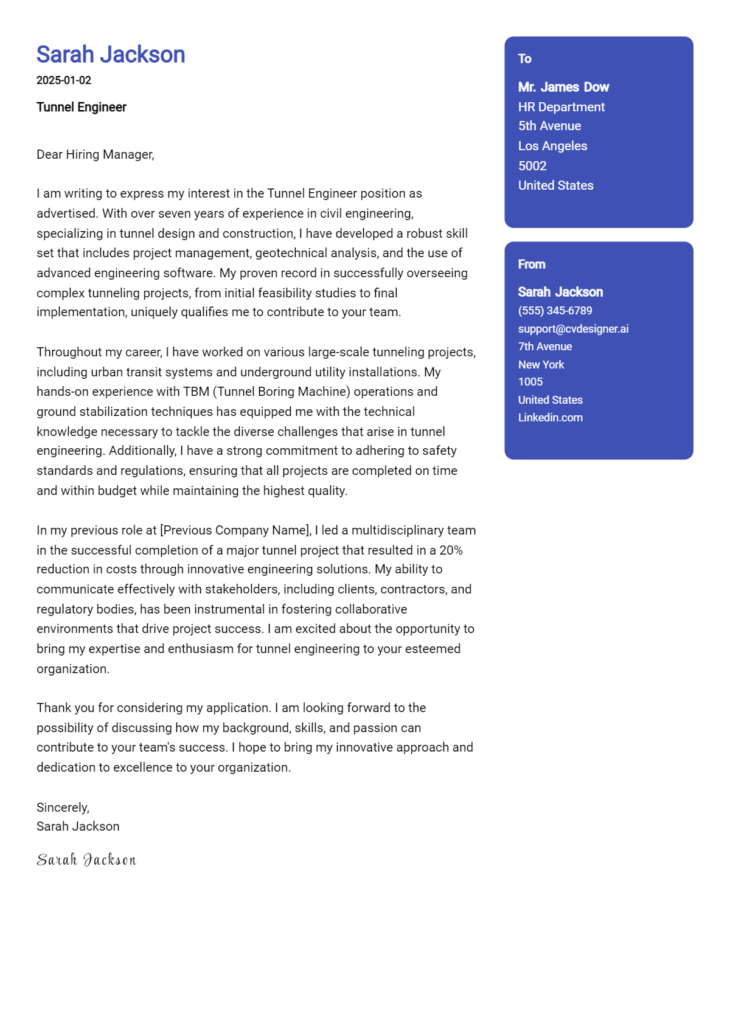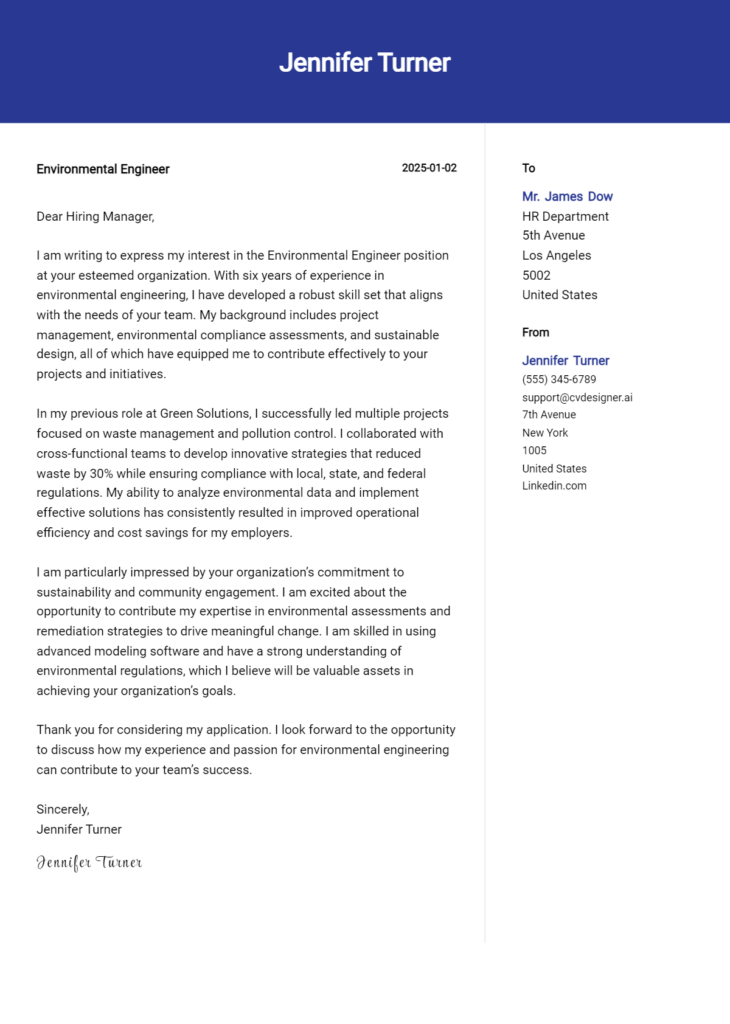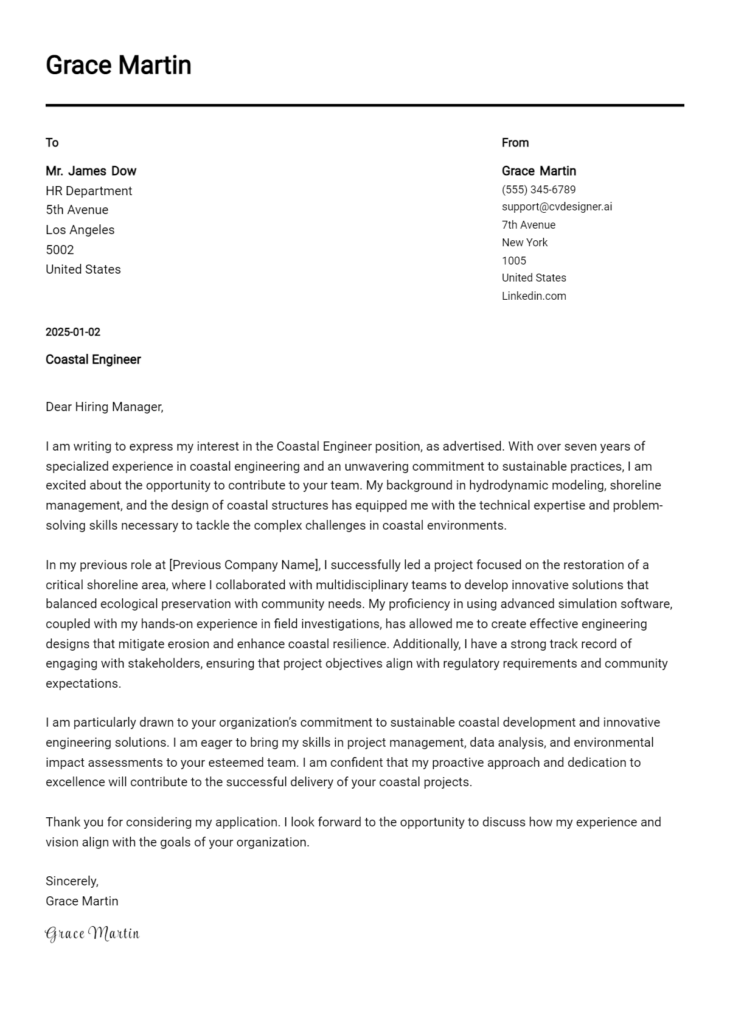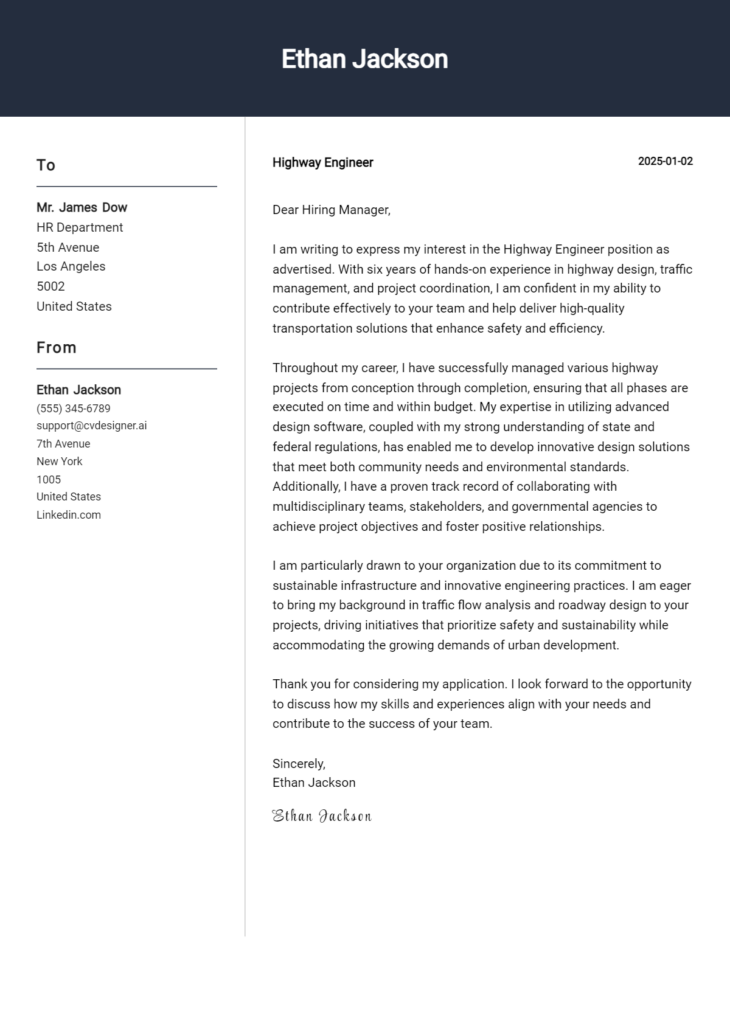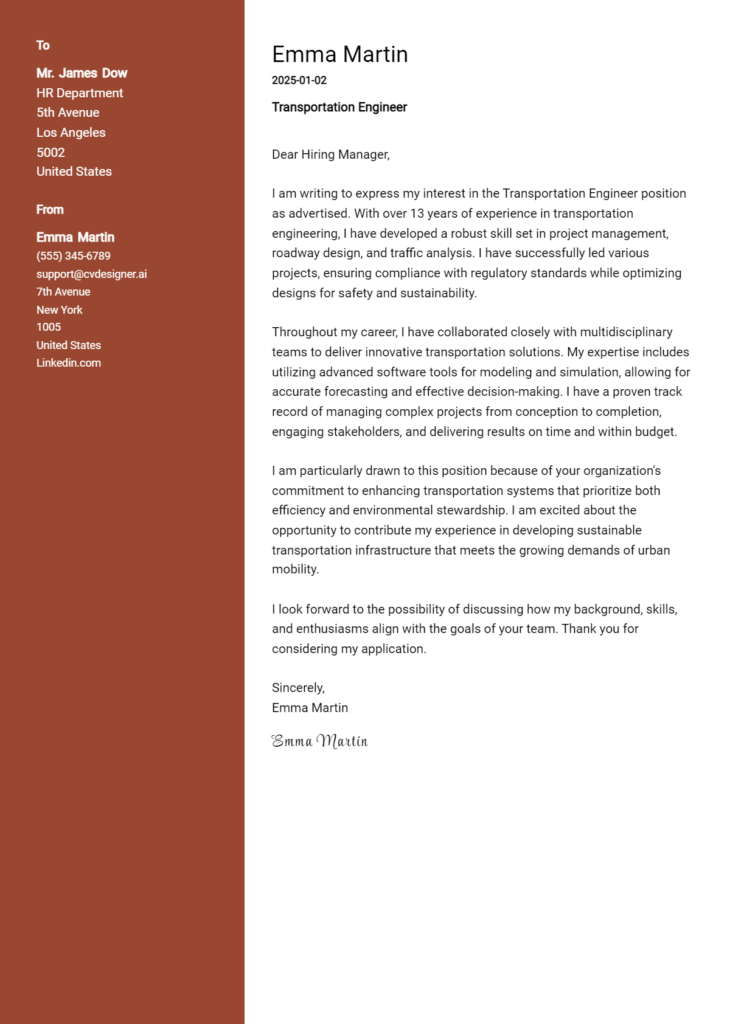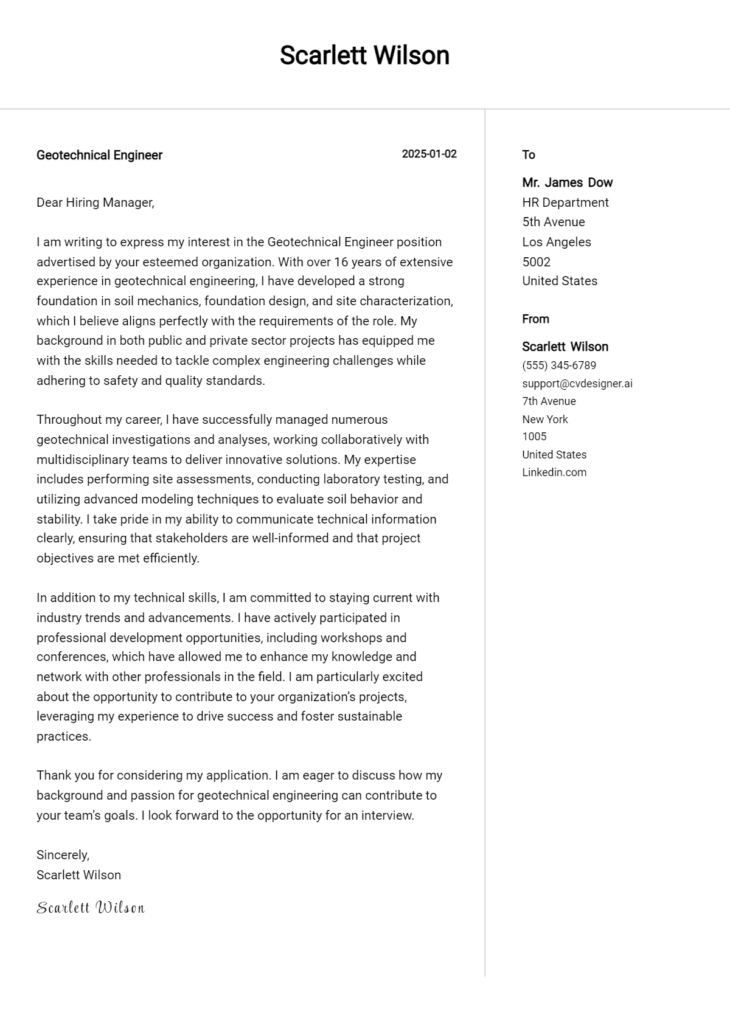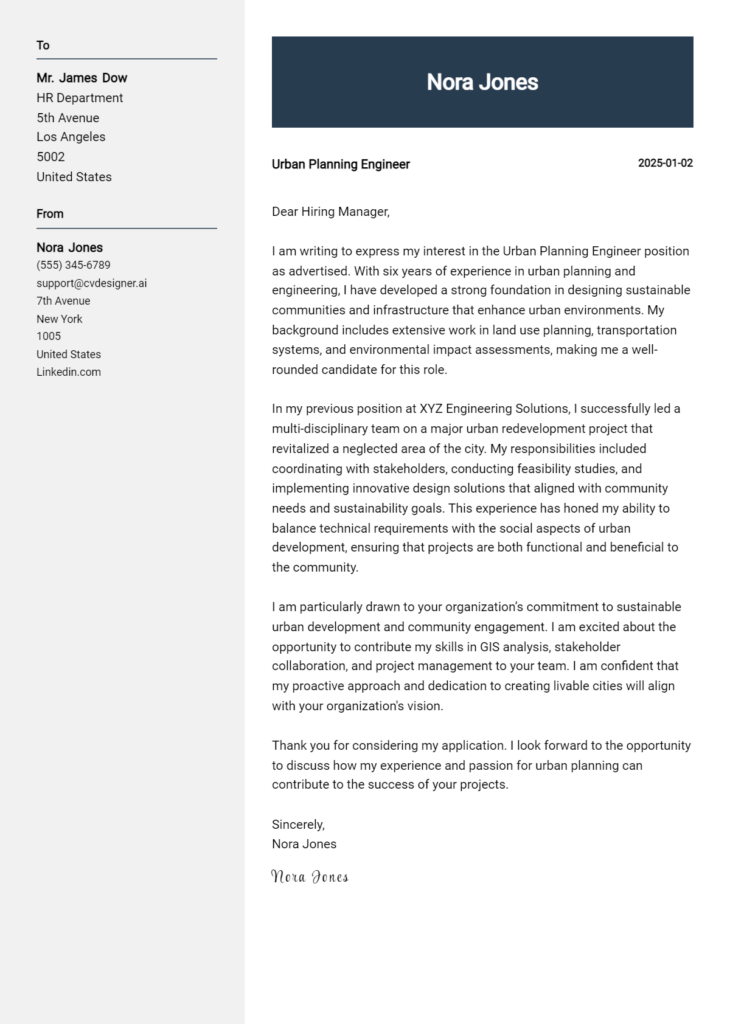Structural Engineer Cover Letter Examples
Explore additional Structural Engineer cover letter samples and guides and see what works for your level of experience or role.
How to Format a Structural Engineer Cover Letter?
Crafting a compelling cover letter is essential for Structural Engineers, as it serves as a vital first impression for potential employers. The way you format your cover letter not only showcases your technical skills and qualifications but also reflects your organizational abilities and attention to detail—traits that are critical in the field of structural engineering. A well-structured cover letter can effectively capture the hiring manager's attention, demonstrating your professionalism and understanding of engineering principles.
In this guide, we will explore how to structure your cover letter, providing insights and examples tailored specifically for Structural Engineers.
We'll focus on the essential components of a professional cover letter, including:
- Cover Letter Header
- Cover Letter Greeting
- Cover Letter Introduction
- Cover Letter Body
- Cover Letter Closing
Each section is crucial in highlighting your qualifications and professional demeanor. Let’s break down each part to help you create a standout cover letter that positions you as an ideal candidate in the competitive field of structural engineering.
Importance of the Cover Letter Header for a Structural Engineer
The cover letter header is a critical component of any professional application, including that of a Structural Engineer. It serves as the first impression and sets the tone for the rest of the document. A well-structured header provides essential information, including your contact details, the date, and the recipient's information. Clarity and professionalism are paramount, as they reflect your attention to detail and commitment to your field. A strong header not only helps the hiring manager identify you quickly but also conveys your enthusiasm for the position.
Here are examples of a strong and a weak cover letter header for a Structural Engineer:
Strong Example
John Doe 123 Engineering Lane City, State, Zip john.doe@email.com (123) 456-7890 October 1, 2023 Mr. Smith Johnson Hiring Manager ABC Engineering Solutions 456 Industry Blvd City, State, Zip
Weak Example
John D. Email: john.doe@email.com 10/1/23 To Whom It May Concern
The Importance of the Cover Letter Greeting
The greeting of your cover letter is the first impression you make on a potential employer, and it sets the tone for the entire document. A well-crafted greeting demonstrates professionalism and shows that you have taken the time to personalize your application by addressing the hiring manager directly. This attention to detail can make a significant difference in how your application is perceived. To avoid generic greetings that may come across as impersonal, it’s beneficial to research the hiring manager's name whenever possible. A specific greeting conveys enthusiasm and respect, indicating that you are genuinely interested in the position and the company.
Strong and Weak Greeting Examples for a Structural Engineer Cover Letter
Strong Example
Dear Ms. Johnson,
Weak Example
To Whom It May Concern,
The Importance of a Strong Cover Letter Introduction for a Structural Engineer
A well-crafted cover letter introduction is essential for a Structural Engineer, as it serves as the first impression that a candidate makes on the hiring manager. This introduction should be engaging and concise, effectively capturing the reader's attention while conveying the candidate's enthusiasm for the role. It should also highlight key skills or noteworthy achievements that align with the job requirements, setting the tone for the rest of the letter. A strong introduction not only piques interest but also establishes the candidate's credibility and suitability for the position. Below are examples of both strong and weak cover letter introductions for a Structural Engineer role.
Strong Example
Dear [Hiring Manager's Name], As a dedicated Structural Engineer with over five years of experience in designing innovative and sustainable structures, I am excited to apply for the Structural Engineer position at [Company Name]. My expertise in utilizing advanced software for structural analysis, coupled with my successful track record of leading projects that enhance safety and efficiency, positions me as a strong candidate to contribute effectively to your esteemed team.
Weak Example
To Whom It May Concern, I am writing to express my interest in the Structural Engineer position. I have some experience in engineering, and I think I would be a decent fit for the job. I have worked on various projects, although I’m not sure if they are relevant to this role.
Purpose of the Cover Letter Body for a Structural Engineer
The cover letter body for a Structural Engineer serves as a pivotal component that allows candidates to effectively demonstrate their technical skills, relevant experiences, and the unique value they bring to a prospective employer. This section is crucial for highlighting specific projects or accomplishments that illustrate the candidate's engineering expertise, problem-solving abilities, and commitment to delivering innovative structural solutions. By detailing significant projects, such as successful completion of high-profile buildings or bridges, and quantifying achievements, candidates can create a compelling narrative that resonates with hiring managers and distinguishes them from other applicants.
Strong Example
As a Structural Engineer with over five years of experience, I have successfully led the design and implementation of several high-profile projects, including the recently completed Green River Bridge, which not only enhanced transportation efficiency but also integrated sustainable practices that reduced environmental impact by 30%. My role involved collaborating with multidisciplinary teams to ensure structural integrity while adhering to stringent safety regulations. Additionally, my proficiency in using advanced software like AutoCAD and SAP2000 allowed me to optimize design processes, resulting in a 15% reduction in project costs without compromising quality. I am excited about the opportunity to bring my expertise in innovative structural solutions to your team at XYZ Engineering.
Weak Example
I have worked as a Structural Engineer for a few years. I did some projects, but I can't remember all the details. I know how to use some engineering software, and I think I can do a good job. I am looking for a position at your company. I believe I would be a good fit because I have some experience.
Importance of the Cover Letter Closing for a Structural Engineer
The closing paragraph of a cover letter is crucial as it serves to succinctly summarize qualifications, reiterate enthusiasm for the position, and prompt the hiring manager to take the next steps, such as reviewing the resume or scheduling an interview. A strong closing leaves a lasting impression and reinforces the candidate's suitability for the role, while a weak closing may fail to convey confidence or interest, leading to missed opportunities.
Strong Example
Thank you for considering my application for the Structural Engineer position at [Company Name]. With my extensive experience in designing safe and efficient structures, combined with my passion for innovative engineering solutions, I am excited about the opportunity to contribute to your team. I look forward to discussing how my skills and background align with the needs of your projects. Please feel free to reach out to schedule an interview at your earliest convenience. I am eager to further explore how I can add value to [Company Name].
Weak Example
Thanks for reading my letter. I think I would be a good fit for the job. If you want to talk, just let me know. I've attached my resume for you to look at.
Crafting an effective cover letter is crucial for Structural Engineer candidates looking to stand out in a competitive job market. This document not only introduces you to potential employers but also provides a platform to showcase your technical skills, problem-solving abilities, knowledge of the Software Development Life Cycle (SDLC), teamwork experience, and a commitment to continuous learning. The following tips will guide you in creating a compelling cover letter that highlights your qualifications and makes a lasting impression.
Tips for Writing a Cover Letter as a Structural Engineer
Highlight Your Technical Skills: Clearly outline your expertise in structural design software, such as AutoCAD, Revit, or SAP2000. Mention specific projects where you applied these tools effectively. This demonstrates your ability to handle the technical demands of the role and reassures employers of your proficiency.
Emphasize Problem-Solving Abilities: Structural engineering often involves overcoming complex challenges. Share a brief example of a problem you encountered in a previous project and the innovative solution you devised. This not only showcases your analytical skills but also your ability to think critically under pressure.
Demonstrate SDLC Knowledge: If applicable, reference your understanding of the Software Development Life Cycle. Explain how your knowledge in this area contributes to better project management and design processes. Employers value engineers who can integrate software solutions seamlessly into their projects.
Illustrate Teamwork Experience: Structural engineering is rarely a solo endeavor. Highlight your experience working in multidisciplinary teams, detailing your role and contributions. Mention any successful collaborations that led to the completion of significant projects, showcasing your ability to communicate and work effectively with others.
Showcase Your Passion for Continuous Learning: The engineering field is always evolving, and employers look for candidates who are committed to professional growth. Discuss any recent courses, certifications, or workshops you’ve attended. This demonstrates your initiative and dedication to staying current with industry trends and advancements.
By following these tips and utilizing resources like cover letter templates and a cover letter builder, you can create a powerful cover letter that effectively communicates your strengths as a Structural Engineer and enhances your chances of securing your desired position.
Common Mistakes to Avoid in a Structural Engineer Cover Letter
Crafting a compelling cover letter is essential for standing out in the competitive field of structural engineering. Avoiding common mistakes can significantly enhance your chances of securing an interview. Here are some pitfalls to watch out for:
Generic Salutation: Using "To Whom It May Concern" can make your letter feel impersonal. Research the hiring manager's name and address them directly to create a stronger connection.
Repeating Your Resume: Your cover letter should complement your resume, not duplicate it. Instead of restating your work experience, highlight specific achievements and skills relevant to the position.
Lack of Customization: Sending a one-size-fits-all cover letter is a missed opportunity. Tailor your letter to the specific job description, demonstrating how your skills align with the company's needs.
Ignoring Formatting Guidelines: A poorly formatted cover letter can be off-putting. Follow a professional cover letter format to ensure clarity and readability.
Focusing Too Much on Salary: Avoid discussing compensation in your cover letter. Instead, emphasize your passion for structural engineering and how your contributions can benefit the company.
Neglecting to Proofread: Spelling and grammatical errors can undermine your professionalism. Always proofread your letter or use tools to catch mistakes before submission.
Not Including a Call to Action: Failing to invite the reader to take the next step can leave your letter hanging. Conclude with a strong call to action, expressing your eagerness for an interview.
For additional insights, you can explore various cover letter examples to help you craft a standout letter that avoids these common mistakes.
Cover Letter FAQs for Structural Engineer
What should I include in my cover letter as a Structural Engineer?
In your cover letter, you should include your qualifications, relevant experience, and specific skills that pertain to the structural engineering field. Start with a strong opening that captures the employer's attention. Mention your degree and any certifications you hold, such as a Professional Engineer (PE) license. Highlight your experience with specific projects, software proficiency (like AutoCAD or SAP2000), and your understanding of building codes and regulations. Don't forget to express your enthusiasm for the role and the company, and ensure you align your values with theirs. A well-structured cover letter not only showcases your technical expertise but also your ability to communicate effectively, which is crucial in engineering.
How do I tailor my cover letter for a specific job?
To tailor your cover letter for a specific structural engineering position, start by thoroughly reading the job description. Identify key skills and experiences the employer is looking for. Then, relate those requirements to your own background and achievements. Use specific examples from your past work that demonstrate your problem-solving abilities, teamwork, and successful project outcomes. Mention the company by name and explain why you are interested in working for them specifically, whether it’s their projects, values, or reputation in the industry. This personalized approach shows that you’ve done your research and are genuinely interested in the position, making your application stand out.
How long should my cover letter be?
Your cover letter should ideally be one page long, comprising three to four paragraphs. This length allows you to convey essential information without overwhelming the reader. In the opening paragraph, introduce yourself and state the position you are applying for. The subsequent paragraphs should detail your relevant experience, skills, and accomplishments, linking them to the requirements of the job. Finally, conclude with a strong closing statement that reiterates your interest and expresses your desire for an interview. Ensuring that your cover letter is concise yet informative will make it easier for hiring managers to quickly assess your qualifications.
What tone should I use in my cover letter?
The tone of your cover letter should be professional yet approachable. As a structural engineer, it's important to convey your technical expertise and serious commitment to the field while also showing personality and enthusiasm. Avoid overly formal language or jargon that could alienate the reader. Instead, aim for a conversational tone that reflects your passion for engineering and your eagerness to contribute to the company’s success. Be confident without being arrogant, and express genuine interest in the role and the organization. This balance will help you connect with the hiring manager and make a positive impression.
Build your Cover Letter in minutes
Use an AI-powered cover letter builder and have your letter done in 5 minutes. Just select your template and our software will guide you through the process.

